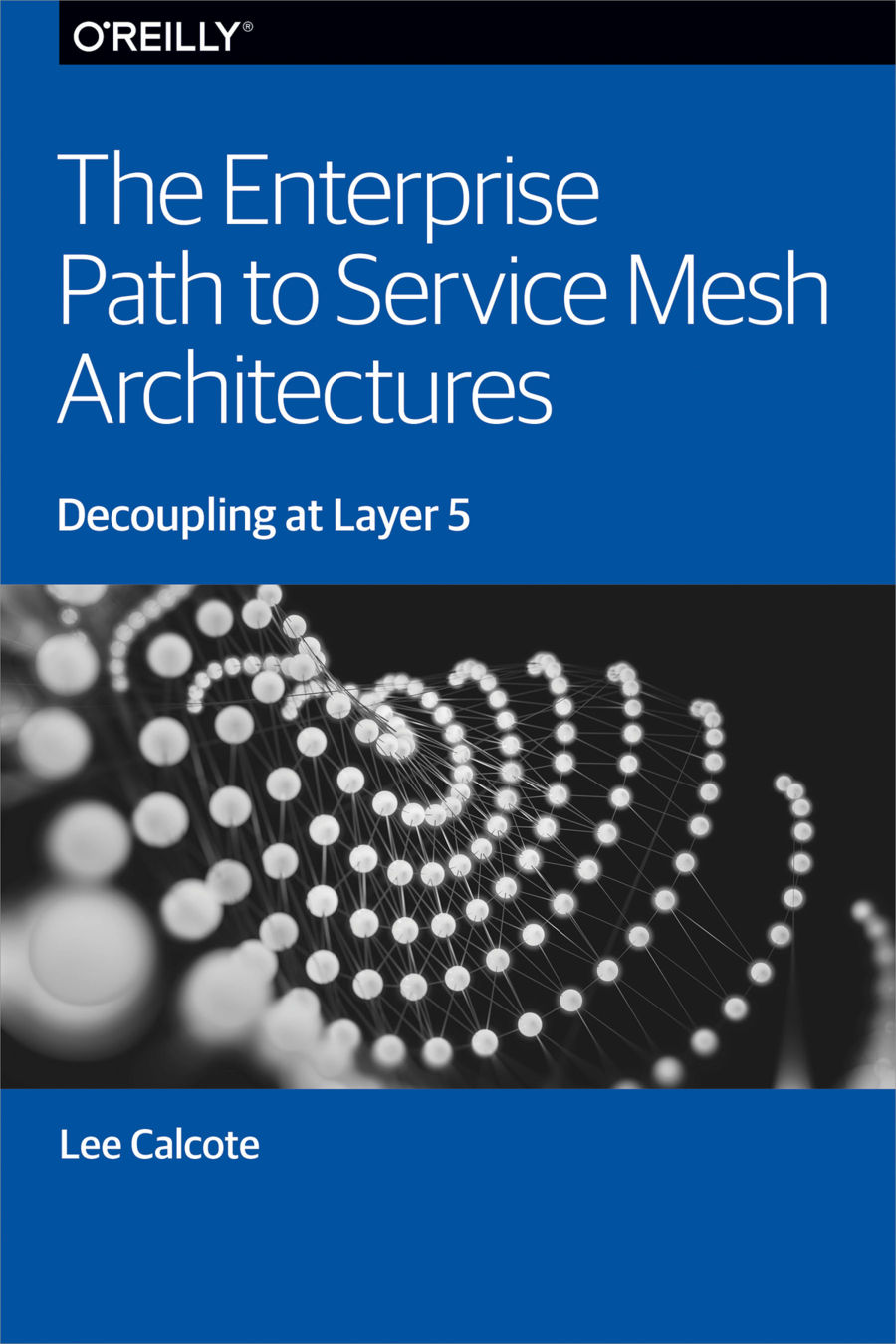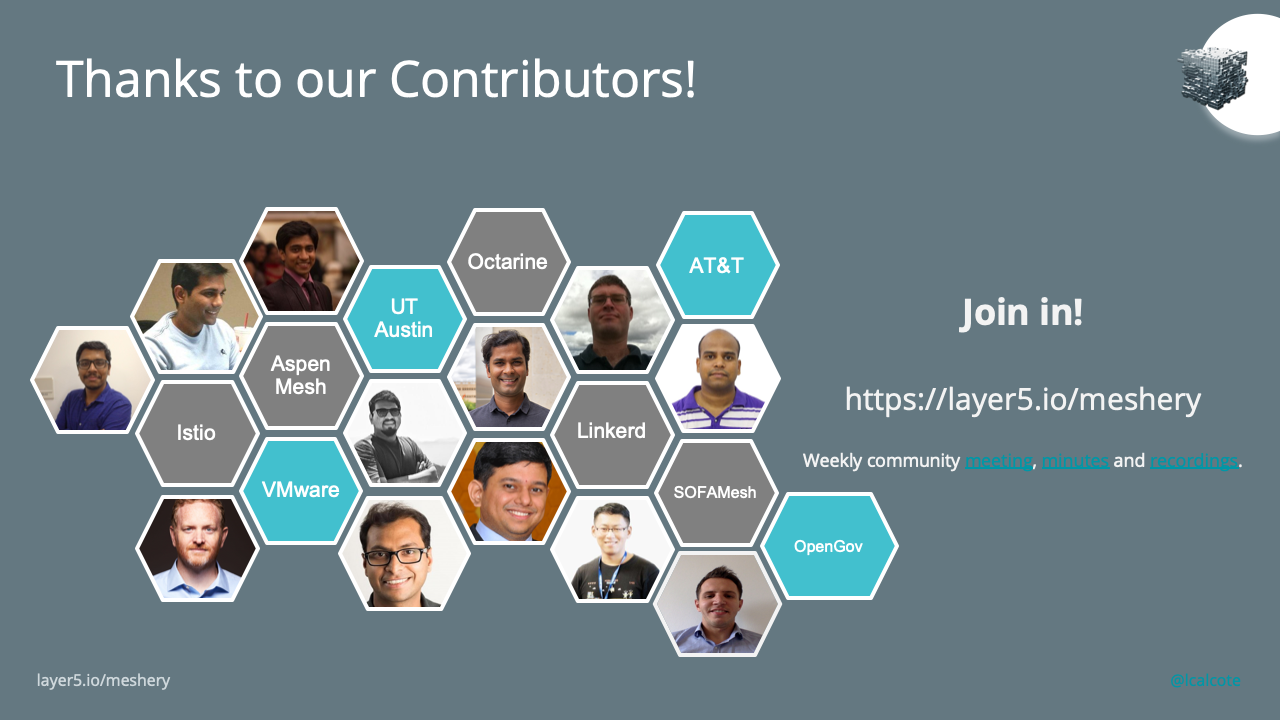Adopting a service mesh

layer5.io/landscape
Adopter’s Dilemma
Which service mesh to use?
What's the catch? Nothing's for free.
Playground
WHICH SERVICE MESH SHOULD I USE AND HOW DO I GET STARTED?
Learn about the functionality of different service meshes and visually manipulate mesh configuration.
Performance Benchmark
WHAT OVERHEAD DOES BEING ON THE SERVICE MESH INCUR?
Benchmark the performance of your application across different service meshes and compare their overhead.
layer5.io/meshery
@lcalcote
Service Mesh Architectures
Service Mesh Architecture
Data Plane
- Touches every packet/request in the system.
- Responsible for service discovery, health checking, routing, load balancing, authentication, authorization, and observability.
Ingress Gateway
Egress Gateway
Service Mesh Architecture
No control plane? Not a service mesh.
Egress Gateway
Control Plane
Data Plane
- Touches every packet/request in the system.
- Responsible for service discovery, health checking, routing, load balancing, authentication, authorization, and observability.
- Provides policy, configuration, and platform integration.
- Takes a set of isolated stateless sidecar proxies and turns them into a service mesh.
- Does not touch any packets/requests in the data path.
Ingress Gateway
Service Mesh Architecture
Control Plane
Data Plane
- Touches every packet/request in the system.
- Responsible for service discovery, health checking, routing, load balancing, authentication, authorization, and observability.
- Provides policy, configuration, and platform integration.
- Takes a set of isolated stateless sidecar proxies and turns them into a service mesh.
- Does not touch any packets/requests in the data path.
You need a management plane.
Ingress Gateway
Egress Gateway
Management
Plane
- Provides monitoring, backend system integration, expanded policy and application configuration.
Pilot
Citadel
Mixer
Control Plane
Data Plane
istio-system namespace
policy check
Foo Pod
Proxy Sidecar
Service Foo
tls certs
discovery & config
Foo Container
Bar Pod
Proxy Sidecar
Service Bar
Bar Container
Out-of-band telemetry propagation
telemetry
reports
Control flow
application traffic
Application traffic
application namespace
telemetry reports
Istio Architecture

Galley
Ingress Gateway
Egress Gateway
Control Plane
Data Plane
linkerd-system namespace
Foo Pod
Proxy Sidecar
Service Foo
Foo Container
Bar Pod
Proxy Sidecar
Service Bar
Bar Container
Out-of-band telemetry propagation
telemetry
scarping
Control flow during request processing
application traffic
Application traffic
application namespace
telemetry scraping
Architecture
destination
Prometheus
Grafana
tap
web
CLI
proxy-api
public-api
Linkerd
proxy-injector
Service Mesh Deployment Models
Client
Edge Cache
Istio Gateway
(envoy)
Cache Generator
Collection of VMs running APIs
service mesh
Istio VirtualService
Istio VirtualService
Istio ServiceEntry
Situation:
- existing services running on VMs (that have little to no service-to-service traffic).
- nearly all traffic flows from client to the service and back to client.
Benefits:
- gain granular traffic control (e.g path rewrites).
- detailed service monitoring without immediately deploying a thousand sidecars.
Ingress
Out-of-band telemetry propagation
Application traffic
Control flow
Proxy per Node
Service A
Service A
Service A
linkerd
Node (server)
Service A
Service A
Service B
linkerd
Node (server)
Service A
Service A
Service C
linkerd
Node (server)
Advantages:
-
Less (memory) overhead.
-
Simpler distribution of configuration information.
-
primarily physical or virtual server based; good for large monolithic applications.
Disadvantages:
-
Coarse support for encryption of service-to-service communication, instead host-to-host encryption and authentication policies.
-
Blast radius of a proxy failure includes all applications on the node, which is essentially equivalent to losing the node itself.
-
Not a transparent entity, services must be aware of its existence.
layer5.io/books

Advantages:
-
Good starting point for building a brand-new microservices architecture or for migrating from a monolith.
Disadvantages:
-
When the number of services increase, it becomes difficult to manage.

Router "Mesh"

Fabric Model
Advantages:
-
Granular encryption of service-to-service communication.
-
Can be gradually added to an existing cluster without central coordination.
Disadvantages:
-
Lack of central coordination. Difficult to scale operationally.

Ingress or Edge Proxy
Advantages:
-
Works with existing services that can be broken down over time.
Disadvantages:
-
Is missing the benefits of service-to-service visibility and control.
Meshery
a multi-service mesh performance benchmark and playground


Configuration
Security
Telemetry
Control Plane
Data
Plane
service mesh ns
Foo Pod
Proxy Sidecar
Service Foo
Foo Container
Bar Pod
Proxy Sidecar
Service Bar
Bar Container
Out-of-band telemetry propagation
Control flow
application traffic
http / gRPC
Application traffic
application namespace
Meshery Architecture
Ingress Gateway
Egress Gateway

Management
Plane
meshery
adapter
gRPC
kube-api
kube-system




Service Mesh Interface (SMI)

+

@lcalcote
layer5.io/meshery
Pod Memory Usage



Application resource consumption


@lcalcote
layer5.io/meshery
Pod CPU Usage



Application resource consumption


@lcalcote
layer5.io/meshery
Control Plane Memory

Istio
Linkerd
Consul
@lcalcote
layer5.io/meshery
Control Plane CPU

Istio
Linkerd
Consul
Relative
Showdown!
Slowdown
@lcalcote
layer5.io/meshery

| Cores | Threads | Istio (2) | Linkerd |
|---|---|---|---|
| 8 | 8 | 1 | 1 |
| 8 | 16 | 1.7 | 1.8 |
| 8 | 32 | 3.2 | 3.4 |
| 8 | 100 | 9.3 | 9.6 |
(2) mTLS on, tracing off
Relative
Showdown!Slowdown
@lcalcote
layer5.io/meshery

| Cores | Threads | Istio (1) | Istio (2) | Linkerd |
|---|---|---|---|---|
| 8 | 8 | 1 | 1 | 1 |
| 8 | 16 | 1.4 | 1.7 | 1.8 |
| 8 | 32 | 18.4 | 3.2 | 3.4 |
| 8 | 100 | 52.2 | 9.3 | 9.6 |
(1) mTLS on, tracing on
(2) mTLS on, tracing off
Service Mesh Benchmark Specification
A project and vendor-neutral specification for capturing details of:
-
Environment / Infrastructure
-
Number and size of nodes, orchestrator
-
-
Service mesh and its configuration
-
Service / application details
Bundled with test results.

github.com/layer5io/service-mesh-benchmark-spec

@lcalcote
layer5.io/meshery

@lcalcote
layer5.io/meshery
a Service Mesh Community

Layer5.io


Meshery

layer5.io/subscribe

